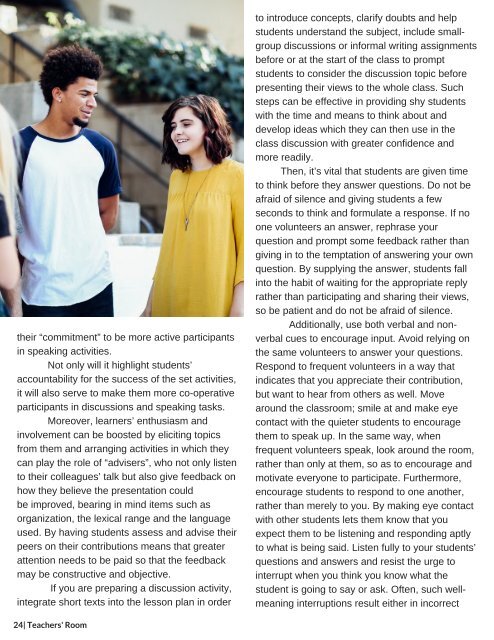IH Porto - Teachers' Room Magazine 2017
Teachers' Room is a magazine made by teachers, for teachers. It includes articles and tips from the IH Porto TT blog, as well as detailed information regarding our TT programme.
Teachers' Room is a magazine made by teachers, for teachers. It includes articles and tips from the IH Porto TT blog, as well as detailed information regarding our TT programme.
Create successful ePaper yourself
Turn your PDF publications into a flip-book with our unique Google optimized e-Paper software.
their “commitment” to be more active participants<br />
in speaking activities.<br />
Not only will it highlight students’<br />
accountability for the success of the set activities,<br />
it will also serve to make them more co-operative<br />
participants in discussions and speaking tasks.<br />
Moreover, learners’ enthusiasm and<br />
involvement can be boosted by eliciting topics<br />
from them and arranging activities in which they<br />
can play the role of “advisers”, who not only listen<br />
to their colleagues’ talk but also give feedback on<br />
how they believe the presentation could<br />
be improved, bearing in mind items such as<br />
organization, the lexical range and the language<br />
used. By having students assess and advise their<br />
peers on their contributions means that greater<br />
attention needs to be paid so that the feedback<br />
may be constructive and objective.<br />
If you are preparing a discussion activity,<br />
integrate short texts into the lesson plan in order<br />
to introduce concepts, clarify doubts and help<br />
students understand the subject, include smallgroup<br />
discussions or informal writing assignments<br />
before or at the start of the class to prompt<br />
students to consider the discussion topic before<br />
presenting their views to the whole class. Such<br />
steps can be effective in providing shy students<br />
with the time and means to think about and<br />
develop ideas which they can then use in the<br />
class discussion with greater confidence and<br />
more readily.<br />
Then, it’s vital that students are given time<br />
to think before they answer questions. Do not be<br />
afraid of silence and giving students a few<br />
seconds to think and formulate a response. If no<br />
one volunteers an answer, rephrase your<br />
question and prompt some feedback rather than<br />
giving in to the temptation of answering your own<br />
question. By supplying the answer, students fall<br />
into the habit of waiting for the appropriate reply<br />
rather than participating and sharing their views,<br />
so be patient and do not be afraid of silence.<br />
Additionally, use both verbal and nonverbal<br />
cues to encourage input. Avoid relying on<br />
the same volunteers to answer your questions.<br />
Respond to frequent volunteers in a way that<br />
indicates that you appreciate their contribution,<br />
but want to hear from others as well. Move<br />
around the classroom; smile at and make eye<br />
contact with the quieter students to encourage<br />
them to speak up. In the same way, when<br />
frequent volunteers speak, look around the room,<br />
rather than only at them, so as to encourage and<br />
motivate everyone to participate. Furthermore,<br />
encourage students to respond to one another,<br />
rather than merely to you. By making eye contact<br />
with other students lets them know that you<br />
expect them to be listening and responding aptly<br />
to what is being said. Listen fully to your students’<br />
questions and answers and resist the urge to<br />
interrupt when you think you know what the<br />
student is going to say or ask. Often, such wellmeaning<br />
interruptions result either in incorrect<br />
24| <strong>Teachers'</strong> <strong>Room</strong>




